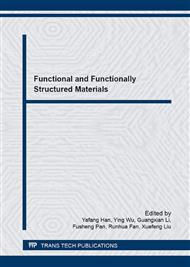[1]
H.Y. Lee, H.K. Park, Y.M. Lee, K. Kim, S.B. Park, A practical procedure for producing silver nanocoated fabric and its antibacterial evaluation for biomedical applications, Chem. Commun. (Camb). 28(2007) 2959–2961.
DOI: 10.1039/b703034g
Google Scholar
[2]
C. Marambio-Jones, E.M. V. Hoek, A review of the antibacterial effects of silver nanomaterials and potential implications for human health and the environment, J. Nanoparticle Res. 12 (2010) 1531–1551.
DOI: 10.1007/s11051-010-9900-y
Google Scholar
[3]
K. -J.K. Kim, W.S.W. Sung, S.S. -K. Moon, J.J. -S. Choi, J.G.J. Kim, D.G.D. Lee, Antifungal effect of silver nanoparticles on dermatophytes, J. Microbiol. Biotechnol. 18 (2008) 1482–1484.
Google Scholar
[4]
S. Agnihotri, S. Mukherji, S. Mukherji, Immobilized silver nanoparticles enhance contact killing and show highest efficacy: elucidation of the mechanism of bactericidal action of silver, Nanoscale. 5 (2013) 7328–7340.
DOI: 10.1039/c3nr00024a
Google Scholar
[5]
J.M. Obliosca, C. Liu, H. -C. Yeh, Fluorescent silver nanoclusters as DNA probes, Nanoscale. 5 (2013) 8443–8461.
DOI: 10.1039/c3nr01601c
Google Scholar
[6]
X. Li, J.J. Lenhart, Aggregation and dissolution of silver nanoparticles in natural surface water, Environ. Sci. Technol. 46 (2012) 5378–5386.
DOI: 10.1021/es204531y
Google Scholar
[7]
X. Li, J.J. Lenhart, H.W. Walker, Aggregation kinetics and dissolution of coated silver nanoparticles, Langmuir. 28 (2012) 1095–1104.
DOI: 10.1021/la202328n
Google Scholar
[8]
H. Lu, L. Fan, Q. Liu, J. Wei, T. Ren, J. Du, Preparation of water-dispersible silver-decorated polymer vesicles and micelles with excellent antibacterial efficacy, Polym. Chem. 3 (2012) 2217–2227.
DOI: 10.1039/c2py20181j
Google Scholar
[9]
G. Dong, X. Xiao, X. Liu, B. Qian, Z. Ma, S. Ye, et al., Preparation and characterization of Ag nanoparticle-embedded polymer electrospun nanofibers, J. Nanoparticle Res. 12 (2010) 1319–1329.
DOI: 10.1007/s11051-009-9665-3
Google Scholar
[10]
P. Khanna, N. Singh, S. Charan, V. Subbarao, R. Gokhale, U. Mulik, Synthesis and characterization of Ag/PVA nanocomposite by chemical reduction method, Mater. Chem. Phys. 93 (2005) 117–121.
DOI: 10.1016/j.matchemphys.2005.02.029
Google Scholar
[11]
K.H. Hong, J.L. Park, I.H. Sul, J.H. Youk, T.J. Kang, Preparation of Antimicrobial Poly(vinyl alcohol) Nanofibers Containing Silver Nanoparticles, J. Polym. Sci. Part B Polym. Phys. 44 (2006) 2468–2474.
DOI: 10.1002/polb.20913
Google Scholar
[12]
S. Lin, R. -Z. Wang, Y. Yi, Z. Wang, L. -M. Hao, J. -H. Wu, et al., Facile and green fabrication of electrospun poly (vinyl alcohol) nanofibrous mats doped with narrowly dispersed silver nanoparticles, Int. J. Nanomedicine. 9 (2014) 3937–3947.
DOI: 10.2147/ijn.s64985
Google Scholar
[13]
R. Wang, Z. Wang, S. Lin, C. Deng, F. Li, Z. Chen, et al., Green fabrication of antibacterial polymer/silver nanoparticle nanohybrids by dual-spinneret electrospinning, RSC Adv. 5 (2015) 40141–40147.
DOI: 10.1039/c5ra03288a
Google Scholar
[14]
A.G. Destaye, C. -K. Lin, C. -K. Lee, Glutaraldehyde vapor cross-linked nanofibrous PVA mat with in situ formed silver nanoparticles, ACS Appl. Mater. Interfaces. 5 (2013) 4745–4752.
DOI: 10.1021/am401730x
Google Scholar
[15]
M. Jin, X. Zhang, S. Nishimoto, Z. Liu, D. a Tryk, T. Murakami, et al., Large-scale fabrication of Ag nanoparticles in PVP nanofibres and net-like silver nanofibre films by electrospinning, Nanotechnology. 18 (2007) 075605.
DOI: 10.1088/0957-4484/18/7/075605
Google Scholar
[16]
S. Shanmugam, B. Viswanathan, T.K. Varadarajan, A novel single step chemical route for noble metal nanoparticles embedded organic–inorganic composite films, Mater. Chem. Phys. 95 (2006) 51–55.
DOI: 10.1016/j.matchemphys.2005.05.047
Google Scholar
[17]
H. Zhu, M. Du, M. Zhang, P. Wang, S. Bao, L. Wang, et al., Facile fabrication of AgNPs/(PVA/PEI) nanofibers: high electrochemical efficiency and durability for biosensors, Biosens. Bioelectron. 49 (2013) 210–215.
DOI: 10.1016/j.bios.2013.04.016
Google Scholar
[18]
S. Pandey, S.K. Pandey, V. Parashar, G.K. Mehrotra, A.C. Pandey, Ag/PVA nanocomposites: optical and thermal dimensions, J. Mater. Chem. 21 (2011) 17154–17159.
DOI: 10.1039/c1jm13276h
Google Scholar
[19]
K. Shameli, M. Bin Ahmad, W.M.Z.W. Yunus, N.A. Ibrahim, R.A. Rahman, M. Jokar, et al., Silver/poly (lactic acid) nanocomposites: preparation, characterization, and antibacterial activity, Int. J. Nanomedicine. 5 (2010) 573–579.
DOI: 10.2147/ijn.s12007
Google Scholar


